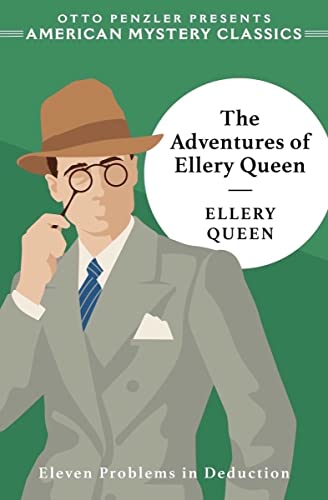The Adventures of Ellery Queen

“Fans of the classic murder puzzle will be very pleased with this edition.”
Aficionados of detective fiction understand the importance of Ellery Queen in the evolution of American crime fiction.
Most popular during the Golden Age in the middle of the 20th century, the stories of Frederic Dannay and Manfred B. Lee, written under the pseudonym of their intrepid hero, presented readers with an American answer to the largely British phenomenon of the whodunit popularized by Agatha Christie, Dorothy L. Sayers, and others.
With his trademark pince-nez eyeglasses and his keen observational skills, Ellery Queen loved nothing so much as a good murder puzzle, and his father, NYPD Inspector Richard Queen, soon came to rely on his son’s skills to solve his most difficult homicide investigations.
The Adventures of Ellery Queen presents modern readers with “eleven problems of deduction” that were first printed in a collection by Frederick A. Stokes in 1934. As Otto Penzler explains in his excellent introduction to his American Mystery Classics edition, the collection was so successful that three other imprints ran with it before Pocket Books took their turn, churning out at least 22 printings.
Penzler’s conclusion? “The overwhelming popularity of this particular book suggests you are in for a treat.”
Ellery Queen relies on a deductive approach, gathering clues in much the same manner as Sherlock Holmes or Auguste Dupin, Poe’s groundbreaking master of “ratiocination.”
In “The Adventure of The One-Penny Black,” for example, Queen must fathom out the connection between a stolen stamp and the theft of multiple copies of the same non-fiction book from different owners.
And in “The Adventure of the Teakwood Case,” a mysterious corpse in an apartment building on West 87th Street that has been plagued with jewelry thefts leads him to the solution of both mysteries: “‘The problem,’ said Ellery, lighting a cigarette and inhaling gratefully under the stony stares of his audience, ‘was after all a simple one, one which admitted of a strictly logical attack.’”
The stories of Dannay and Lee show their age in many instances, and some modern readers may be put off by certain remarks or behaviors that were considered acceptable at the time but are now out of favor with respect to race relations or attitudes toward women.
The writing still retains much of its charm, however. Describing the bookseller whose copies of Europe in Chaos have been stolen at the beginning of “One-Penny Black,” we’re told he was “a frail little fellow; he wore a pair of thick-lensed goggles and there was a smell of suburbs about him.”
And in “The Adventure of The Teakwood Case”: “‘Certain lines of reasoning are inevitable,’ said Ellery, in a dry lecture-voice; he looked at none of them, seeming to be addressing the congested veins in John Lubbock’s dead neck.”
Otto Penzler’s classic reprints are a great contribution to the private libraries of mystery aficionados, and fans of the classic murder puzzle will be very pleased with this edition. At a time when many copies of this particular collection are now encased in mylar sleeves and stored on shelves for safekeeping, having become fragile with age, readers will be glad to possess a serviceable reading copy to pore over once again, hoping to beat young Queen to the solution.